Suspected 2,4-D-Resistant Waterhemp
Waterhemp Population Potentially Resistant to 2,4-D Found in Iowa
JEFFERSON CITY, Mo. (DTN) -- Add Iowa to the list of states where populations of waterhemp resistant to the herbicide 2,4-D may now reside.
In a Feb. 13 post on the Iowa State University (ISU) Integrated Crop Management News website, ISU Extension field agronomist Meaghan Anderson wrote that in late January, Corteva reported the discovery of a suspected 2,4-D-resistant waterhemp population in Wright County in north-central Iowa. Two samples of waterhemp seed -- one from plants in the field and one from a plant growing in the ditch next to the field -- were collected by a Corteva employee.
In an email response to DTN, Anderson said that while she was not aware of the field's complete cropping history, it was her understanding that Enlist soybeans, which are tolerant to 2,4-D, were grown in the field in 2021 and 2022. The herbicide was also used several years for weed management in the ditch.
"This reinforces the belief that the primary driver in herbicide resistance development in weed populations is repeated exposure to the same active ingredient over time," Anderson said.
In greenhouse testing, plants grown from waterhemp seed collected from the ditch did initially appear to be resistant to 2,4-D; plants from the field population did not. Further evaluation is underway to confirm resistance by Corteva, Anderson wrote.
If resistance is confirmed in the ditch population, Iowa will become the fourth state where 2,4-D-resistant waterhemp has been found, joining Nebraska (2009), Illinois (2016) and Missouri (2018). There is already documented resistance to six herbicides groups in Iowa waterhemp populations. They include Group 2 (ALS inhibitors), Group 4 (auxins), Group 5 (triazines), Group 9 (glyphosate), Group 14 (PPO inhibitors) and Group 27 (HPPD inhibitors).
P[L1] D[0x0] M[300x250] OOP[F] ADUNIT[] T[]
In 2019, ISU screened populations of waterhemp against several herbicides at its labeled 1X rates. On average, waterhemp exhibited 17% survival to 2,4-D, 5% survival to dicamba and 4% survival to glufosinate. Last fall, two waterhemp populations in Iowa were reported to be resistant to dicamba. Read more here: https://www.dtnpf.com/….
BEST MANAGEMENT PRACTICES
Anderson offered the following best management practices to slow the evolution of herbicide resistance and improve weed control:
-- On a field-by-field basis, select an effective herbicide program for the weed spectrum present.
-- Use full rates of residual herbicides and plant in a weed-free seedbed.
-- Include overlapping residual herbicides and multiple herbicide groups in post-emergence applications to provide longer waterhemp control. Consult manufacturers for specific tank-mix recommendations.
-- Make timely applications and choose appropriate adjuvants, nozzles and application volume.
-- Scout fields 7-10 days after post-emergence herbicide applications to evaluate weed control.
-- In addition to chemical options for weed control, integrate other mechanical or cultural tactics, including narrow row spacing, cover crops, more diverse crop rotations or tillage.
-- Control weed escapes prior to seed production to reduce future weed populations and prevent resistance from spreading.
-- Reduce influx of weed seed into crop fields by managing weeds in field edges and cleaning equipment between movement from problematic fields to clean fields.
Anderson added that incidences of non-performance of products and suspected herbicide-resistant weed populations should be reported to their respective manufacturers.
Jason Jenkins can be reached at jason.jenkins@dtn.com
Follow him on X, formerly known as Twitter, @JasonJenkinsDTN
(c) Copyright 2024 DTN, LLC. All rights reserved.






